Schnellbootes
 Germany (1934-45)
Germany (1934-45)
Schnellboote – 9 classes*, circa 300 total +280 ordered
The perile of S-Bootes: Called S-Boote (short for “Schnellboote”, literally “fast boats”) and known as the “E-Boats” by the allies (“E” for enemy, and also encompassing R-Boats), these nimble torpedo boats caused much concerns to the allies. Less than U-Boats though, but they still made dangerous all approaches of the occupied coast of Europe, roamed the Baltic, the black sea, Mediterranean, and all along the Atlantic wall, from Norway to the bay of Biscaye. They were especially active in the English channel, and obscured by the “big naval battles” that made headlines, there met in countless unnamed naval clashes against British light gunboats (MGB) and MTBs. They obliged the Royal Navy to develop and maintain a massive fleet of light boats. Somewhat overlooked for their action in the Kriegsmarine, they did performed quite a sizeable damage of their own:
S-Bootes in total for WW2, on all fronts, claimed 101 merchant ships (214,728 GRT), 12 destroyers, 11 minesweepers, 8 landing ships, 6 MTBs, 1 torpedo boat, 1 minelayer, 1 submarine, and many smaller craft. They damaged 2 cruisers, 5 destroyers, 3 landing ships, 1 repair ship, a naval tug and many, many merchant vessels. Also S-Boote and R-boote laid minefields which claimed 37 merchant ships (148,535 GRT), a destroyer, two minesweepers, and four landing ships during the war. Development started during the interwar, but really took of during wartime. Indeed at the outbreak of WWII, only 18 Schellboote were in service. Howver until 1945, 230 more were build, and more planned and latter cancelled. All shared the same basic design, propulsion and armament, and were designed and build at Lürssen, Vegesack.
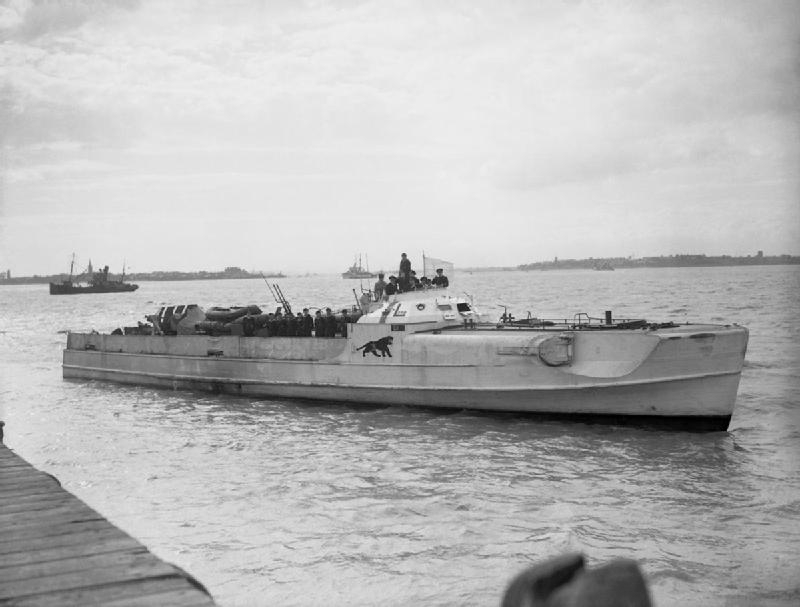
German E-Boat S-204 surrenders at Felixstowe, 13 May 1945
Early developments: The inheritance of WW1
Experience with Fast torpedo Boats started during the Great War. Development of these German torpedo boats launch really started in 1922, when earlier units ordered for the Hochseeflotte in 1917 were completed or remained on slip. These were the LM20s, 21, 22, 22, 23, 26, 27 and 28, which served as testbeds, reformed in the 1930s. The Versailles Treaty was unclear concerning this type of ship, used rather for defense. But as a precaution the first researches were carried out secretly by S. Lohmann in 1923, culminating in Abeking & Rasmussen’s making of the “K”, a prototype capable of 40 knots, based on a Thornycroft type, purchased and studied. Called the Lür it was built by Lürssen, Vegesack. She was capable of 33.5 knots. Later, Caspar Werft’s Narwhal was able to reach 34.8 knots. All of these early units were reclassified as submarine hunters (U-Boote zestorer) or UZ11-18 in 1929.
While the German navy managed to create an effective training system in 1925, was taken the decision by Admiral Fortlotter, of studying a new generation high-speed torpedo boats and the first flotilla was organized. The first exercises were held in 1925. In 1928, the leadership of the Wehrmacht began to show interest in the Fr. Lurssen Bootswerft, where speed boats were built. And already in 1929 the first torpedo boat was built at the shipyard after a long break at the initiative of Admiral Raeder. On July 7, 1930, the UZ(S)16 U-BOOT Zerstorer entered service, renamed by March 16, 1932 “S1”. This 40 tons boat was armed with two 21 inches (533 mm) torpedo tubes and was capable of 32 knots. Soon it was named in the Kriegsmarine ordnance, the “Schnellboote S-type”, under the general category of Kleinkampfverbande.
The Reichsmarsine always had this option and opportunity to build a maximum of these inexpensive ships, not limited in any way. But the Navy leadership was still worried however about a possible reaction to the rapid development of this new class of warships. Early development and testing within the Reichsmarine were carried out under the strictest secrecy, via civilian shipbuilding, and Lürssen, well known for its yachts, was the perfect cover. From 1932 already, the Reischmarine ordered four more of these to be built, S2-S5. In 1933, the S6 marked a new standard and it became a decisive step forward. The German navy was indeed the first to procured these vessels with powerful diesel engines. They both allowed a far superior cruising range while keepin the top speed up to 36 knots, which was destroyer standard.
In 1934-1935, while the fleet was in full transition oto becom the Kriesgmarine, seven more (S7-S13) were ordered, and by July 1935, a first torpedo boat flotilla was created. Next appeared the 92 tonnes serie S14-S17, fitted with three diesel engines for 2000 shp and 39.8 knots. They went into the first flotilla of S-boats and the olest went to the 2nd and 3rd flotillas. In all, 12 of these standardized S-Boats were ready for defense. In 1936-1938, the tactical and technical requirements changed, as these nimble ships were now to be able to patrol up to 700 miles, from the west coast of Germany and deep into the North Sea, and Baltic Sea eastwards to the islands of the gulf of Finland. Diesels were improved, and speeds up to 45 knots could be reached. There was no shortage of young commanders for these vessels, armed with deadly torpedoes and AA, and lightning speed. S-Boat Sailors however were carefully selected and had a special training, including mechanics and navigators.
In the Kriegsmarine, S-Boats tasks were defined, and first their primary mission was to attack large ships, and secondary, to infiltrate harbors and bases, preying on merchant lines following sea routes, and raiding bases and installations along and enemy coast. In addition, S-Bootes should be capable of defensive operations, ASW patrols and coastal convoy escort, but also reconnaissance and minesweeping. Torpedo boats had also many advantages of speed and discretion, minimal crews and supplies and low cost.
About Lürssen Vegesack
Four years after the proclamation of the German Empire, on 23 July 1875, Fr. Lurssen founded the company in Bremen. Already in 1890, the yard was producing the first German high-speed boat. By 1910, 700 left the shipyard’s slipways, well noted internationally for their top speed for that time. In 1917, Fr. Lurssen Bootswerft received an order from the Navy for a first torpedo boat, launched and active. The company in 1916 provided also remote-controlled boats to enter occupied ports or attacking heavily armoured ships for the fleet. The yard swelled and started to built shallow minesweepers (F boats) and submarines and also its first military launches of the ML class.
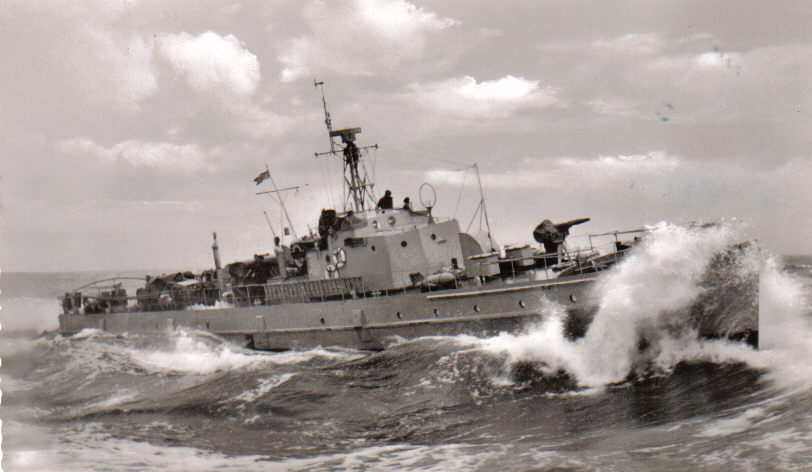
Lürssen also produced large quantities of coastal minesweepers/Minelayers during WW2 (Raümboote or “R-Boats”), but wartime production was taken over by Abeking & Rasmussen, Lemwerder and
Schlichting, Travemünde.
After world war I, treaties focused on large warships and measures taken to limit the fleets never applied to surface ships below 600 tons. Each country could develop and launched these in any quantity which it saw fit, at discretion. The role of TBs was largely underestimated by the naval powers in 1919, and the idea of speedboats used for combat operations seemed ludicrous or a waste of time fr the admiralties, for which the only credo t of the time was still Mahanian, revolving around battleships. This view prevailed, even despite some spectacular successes, like the Italian MAS. Lürssen meanwhile had shrink from 700 to 100 employees. Since the main plant in Aumund was entirely burned down, a new plant was established to Vegesack by 1924, which became the main yard we know today. Civilian production restarted, and the company, still searching advertising sold in the USA the world’s fasted yacht, Oheka II, equipped with three Maybach engines for 34 knots. In 1929 the Reichsmarine ordered the UZ (S) 16 for testing, 28m long and weighting 51.6 tons. It became the S1 in 1932 and by 1933 the model became the basic pattern for German military TBs, an activity which was now played in the open. In 1929, minesweepers restarted in cooperation with Abeking & Rasmussen. Before and during the war, the company (with a network of suppliers and subcontractors) produced some 250 S-Boats, with 280 more on order in 1945. These boats became much more important as the war became defensive. The loss of the French coast curtailed however their use.
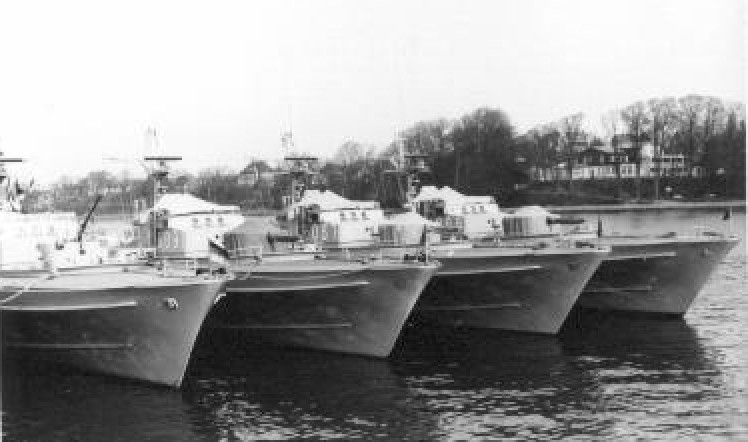
The Jaguar class were classic MTBs of the 1960s very much in inheritance of WW2 S-Boote. The next decade saw the company looking for FACs
Lürssen Vegesack returned to civilian production after the war, starting in 1946 to produce fishing cutters, and back from captivity in 1947, the brothers Gert and Fritz-Otto Lürssen reorganized the company, which became in 1952 Lürssen-Werft, obtaining orders for fast patrol boats. But the game changer truly was the building of the Jaguar in 1959 for the Bundesmarine. Inspired by WW2 era S-Boats, it was larger and more powerful, and attracted a lot of attention of many navies around the world. Exports started to built in the 1970s as the company teamed with France for the “La Combattante” serie of large, fast patrol boats (FPB). The company also built large patrol vessels and minesweepers. Official website. The company also never stopped its yacht production, breaking new records.
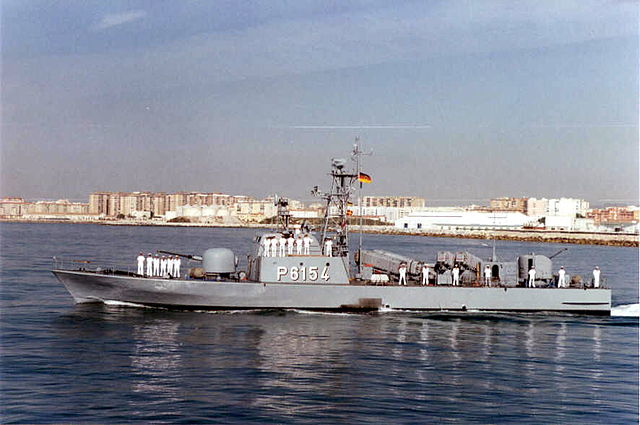
Elster (P6154), a fast attack craft of the Tiger-class
Technical evolution and specifics

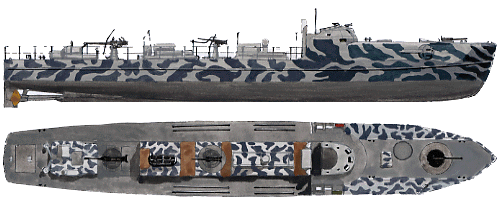
S38 and S100 group, Author’s illustrations. more are awaited.
In 1930 Kriegsmarine’s design department took over the design of the fast yacht Oheka II built for an American customer, and the Lür, to design the new generation of VLTs. It was, in 1930, the S1, built by Lürssen, like all those who followed until 1945. It was followed by the S2 to 5, all sent in 1938 to Nationalist Spain. These first units, 27 meters long for 40 to 46 tons, ran 34 to 33.8 knots but all had only two torpedo tubes for two in reserve.
Propulsion of S-Boote
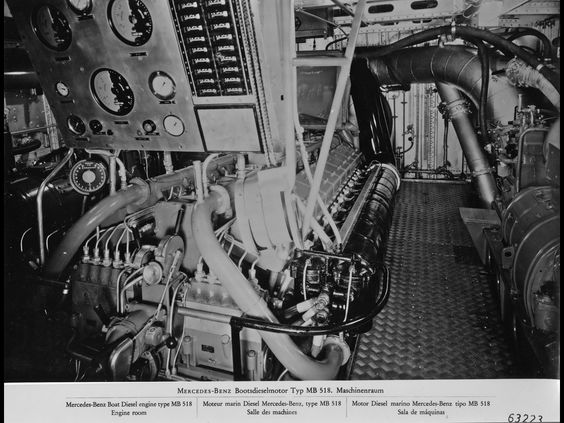
MB518 diesel, credits dave-mills.yolasite.com. Newly discovered German photos of this V20 Type MB 518 used in late E Boats later captured at Menai Bridge, inspected by Saunders Roe staff. The Expert Kalle Scheuch suggested MB 501 or MB 511 were more common, the latter likely used on the S701 boats.
Almost of boats were propelled by Daimler-Benz engines, generally diesels, but with a few exceptions:
-The experimental S1 had petrol engines, as well as the S-2 group in 1932. The S3 group had MAN diesels in 1934, and the standard arrived with the S-10 group of 1935, the first with Daimler-Benz diesel engine, which procured the range which was lacking on previous series, while still able to procure them 35 knots.
These Marine Daimler-Benz models were upgraded constantly. On the S-100 group they were of the MB 501 model, procuing together an output of 7,000 bhp. This was truly remarkable for 100 tonnes ships, allowing a top speed of 44 knots. Power output always splitted betwene three shafts, three engines from the S1, rose indeed from 2,700 bhp to 1960 on the S6 to S30, 6000 on the S38 group and 7,000 on the S100 group, and 5,00 bhp more on the S701 group.
Armament of S-Bootes
S-Boats were armed with torpedoes, followed by light QF autocannons and machine guns. This light artillery by September 1939 was typically a single 20 mm Rheinmetall C/30 FLAK autocannon on a L/30 mount installed aft on a platform, and two pintle-mount Mauder 7.92-mm MG 34 LMGs. On the S-38 serie, a second autocannon was placed in a deck turret on the forecastle. The S-30 were retrofitted that way at the end of 1941. These guns however had a relatively low rate of fire and reliability, which caused frequent criticism and by 1941-1942 they were replaced by the C/38.
Due to frequent clashes with Royal Navy’s MGBs drastic measures were taken to strengthen the armament. The standard 37-mm semi-automatic C/30 was no longer suitable as only capable of 40 rpm. The obvious alternative was the Swedish 40 mm Bofors and from October 1942, three boats in each of the 1st, 2nd and 4th flotillas, two in the 5th and 6th fleets, received a Bofors at the stern. In total, 14 S-Boats were so rearmed: The S-29, S-39, S-42, S-44 – S-46, S-51, S-81-S-83, S-98, S-99, S-112, and S-117. However the Bofors still had a low rate of fire and no armor-piercing shells. It became clear for the Kriegsmarine, that there was no other weapons suitable for these S-Boats. Still, the 50 mm Flak 41 developed for destroyers weighed over 3 tons, and a lightened version of the MK-103 30 mm airborne cannon was under development for future marine applications.
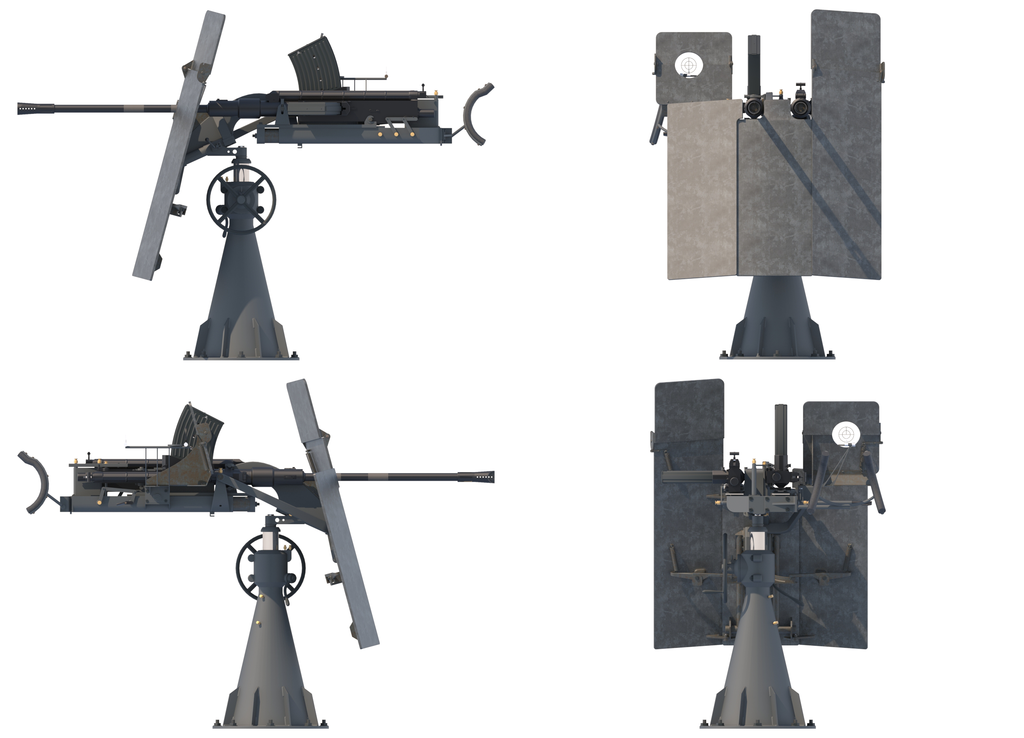
2cm Flak C38 in a M43U Zwilling Mount
Nevertheless, some S-boat commanders improvised, and fitted at the stern a paired 20 mm autocannon (S-65) or a quad mount (Flakvierling). Another favorite location was behind the wheelhouse, and there a single or twin 20 mm or a twin or triple 15 mm MG-151/15 MG could fit. There is even evidence of the use of 20 mm MG FF cannons in improvised mounts. Cramming the deck with such installations, this went up to eight cannons and MGs. In early 1944, the 30 mm autocannon became available and were fitted from the S-170 onwards, in complement of twin C/38s installed behind the wheelhouse as a standard. Late 1944, stern mounted with a single 37 mm (Flak 36/Navy M42) was alternative to a 40 mm Bofors. The planned rearmament by a 30 mm MK-103 gun was never fully implemented. The twin 30 mm mounts never achieved its development, and two single MK-103 were installed instead. In 1944, some S-Boats even had a 86 mm RAG M42 multiple rocketed launcher system with AA rockets, in standard 30 fragmentation rockets and 60 incendiary rockets.
Torpedoes:
Designers found it much easier and faster to develop self-protection of E-Boats, than practical way to launch torpedoes. The great advantage was to use large tubes to carry standard anti-ship 21-inches models (53 cm). They were powerful and largely available. Steam-gas models were improved, but electric models were also tested by S-Boote but not used operationally. They were stealthy, not betrayed by a trail of bubbles but slower with a lesser range and only used by U-Boats which approached masked. Stastically torpedoes were not very successful however as for all the torpedoes fired during the war, destroying 369 warships it took on average 82 torpedoes to sink a single ship. On E-Boats, German engineers wrapped their head around problems such as avoiding the torpedo to explode just after launch at high speed, when colliding with a wave. Fixed bow, low above water, seemed the best way, as the missile nose forward. Launch from the stern, the old way of WWI, was more complicated and dangerous.
The typical L7 models carried was 718 cm long for 53,3 in diameter, weighting 1,528 kg. and hed three speed settings: 30, 40 and 44 knots with cruising ranges respectively of 12,500, 7,500 and 5500 m. They carried a 280 kg warhead using a fuse detonator of the KHB Pi1 or KHB Pi1 8.43-8.44 types, which could be setup for non-contact explosion.
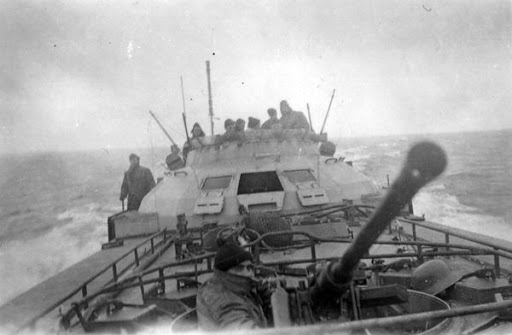
General advantages and issues of the E-Boats
E-Boats were strongly built. Accidental fires were rare, and they could resist the ramming blow of a destroyer, a mine explosion or 4-in shells. As an example, on March 15, 1942, S-105 came back to base riddled by 80 shell fragments, bullets and shell holes. Their enormous cruising range, up to 800-900 miles at 30-knot was an eneormous advantage over traditional MTBs, but they operated mostly by night, early on during the conflict. They were also very stabled due to their elongated round bilge contours. From the S-100 in particular, the armoured forecastle and built-in torpedo tubes improved the overall seaworthiness, and S-Boats were still able to fire and function on a force 4-5 gale, while keeping a low silhouette. Comparative tests were made between German and British boats after the war. They showed by night, E-Boats were more stealthy while still able to spot the enemy first. The main criticism revolved around their on-board artillery, falling behind the British. In terms of detection also, S-boats lagged behind their opponents as they never received a small-sized radar. When the Germans deployed the Naxos radio intelligence station, the situation improved, but this was still not worthy of a radar. By 1944, the British adopted the Foxer, a ship-towed device diverting the torpedo towards itself, with a “bait” which was the device own acoustic field, more intense than the ship’s propellers noise. Until the German deployed their Lerche wire-controlled torpedoes.
ASW equipments:
Late schnellboote were equipped with two aft grenade throwers and racks for six WBF depth charges 139 kg each for ASW warfare. Commanders indeed had the idea of droppin these depht charges into the wake of pursuing vessels.
Active protection:
Smoke canisters were also carried (Nebelkannen), two, and up to eight, including German and French models. Each layed a blanket of smoke lasting 20 minutes.
Mines:
Mines were not included as standard but experiments started before the war and the first S-Boat minelaying mission took place on the night of July 11, 1940, in British waters. It was a success, to they started to be more widely used by S-Boats and became more effective at the end of the war. Due to the allied air superiority, these missions were mostly performed by night in 1944.
S-Bootes in action
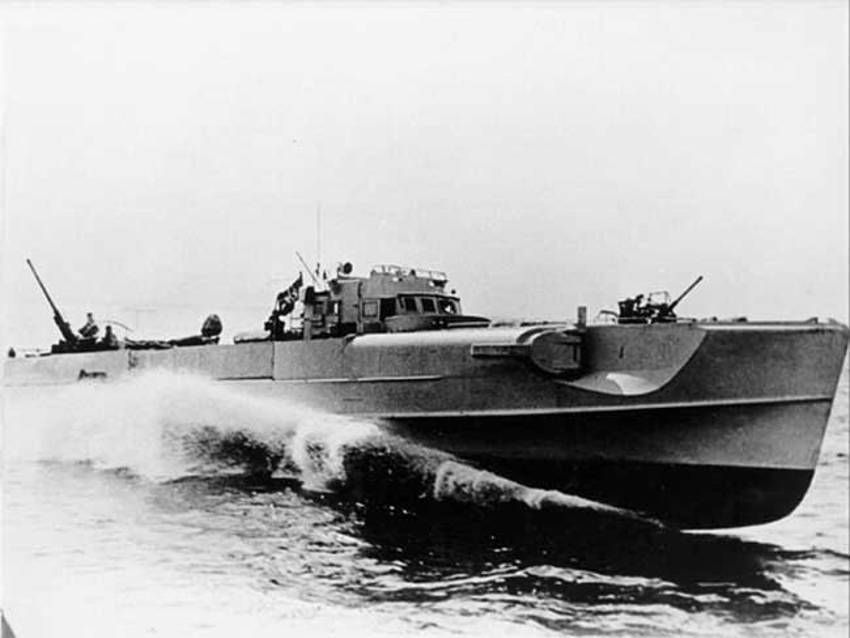
The Kriegsmarine started the war with the S38 group; with their two tubes and four torpedoes, two 30mm FLAK and 42 knots, they could create a fear factor in coastal operations.
Operations with the Kriegsmarine started with the Baltic Sea in 1939, and the north sea German coast, until the western campaign in May-June 1940. The fall of France opened the while French coast to S-Bootes, which now could prey at leisure in the English Channel. They started earlier, thanks to their range, intercepting shipping from and to English ports. This became a reisky business, forcing the British to devise a brand new category of gunboats to patrol the channel. Slow, but with long range and bristling with guns, their main task was to intercept and destroy E-Boats. In May 1940 already at Dunkirk, E-Boats were roaming the channel, preying on troopships.
The Dunkirk evacuation (May-June 1940)
The press started mentioning S-Boote at the end of May 1940, during the nine-day evacuation of the BEF and some French troops from Dunkirk and other coastal cities. They just republished German radio announcements; Like in May 22, 1940 when a British auxiliary cruiser was sunk in the English Channel or in May 26, in Ostend, when it was a Bitish destroyer and off Gelder, a submarine.
In June, these were the destroyers HMS Basilix, Keith and Havant and in all 24 vessels were lost, less than E-Boats than from mines, U-Boats and the Luftwaffe. The British established three routes across the English Channel to be defended: The central, western and eastern roads. On May 28, British and French ships used the eastern route down to the Quintwisle buoy, one hour from Ostend, from where German torpedo boats operated. On May 29 they sank HMS Wakeful with troops on board as she broke in half. HMS Grafton and the minesweeper Lidd picked up survivors, later joined by the drifter Nautilus and pilot ship Comfort, but Grafton was torpedoed by another S-Boote, unnoticed.
HMS Comfort and Nautilus moved away and panic led to friendly fire which added to casualties. HMS Comfort was also torpedoed. The English historian D. Devine analysed and compared document records of opposing forced in Dunkirk, and found the British lost in reality 226 out of 693 ships including 6 destroyers, 5 minesweepers and around 200 small ships and about the same number more or less seriously damaged. Three German torpedo boats flotilla took part in the operations by late June, but it only started from 21 May, when two flotillas were transferred from Norway, operating on the southern part of the North Sea. This was not a spectacular single battle at open sea, and the press seldom mentioned it. The operation cost far more than the press was relating, not to cripple the nation’s morale. Many mines were laid by the German aviation, which recorded most of the kills.
S-Boote Flotillas
After the Dunkirk evacuation and from other French cities along the coast, several flotillas were based, but they also soldiered on in Norway. Here are these records.
– 1st flotilla Baltic 1939, Polish campaign, Operation Weserubung, transferred to the West, Baltic summer 1941, Finland. 1942-44 Black Sea (Romania), 1944 Baltic.
-2nd flotilla: North Sea 1939 (S-10-S-17), Operation Weserubung, Ostend, to operate in the English Channel. Summer 1941, Baltic, Finland. 1942-45 English Channel. They were supplied by the requisitioned ex-Chinese tender and floating base KMS Tanga.
-4th flotilla: Created 1.10.1940, North Sea, English Channel. 1944: Belgian Canal Zone, HQ Rotterdam.
-5th flotilla: Created 07/15/1941 Finland. 1941-44 English Channel, 1944 Helsinki & Reval. In 1944–45 Swinemunde, Baltic, and English Channel.
-6th Flotilla: Created 1.3.1941 station “Nordsee”. English Channel, 1942 Norway, and back. 1944 Finnish waters, and back.
-8th flotilla Created 11/01/1941 Norway, Kola Bay area, Murmansk convoys. disbanded 1942, recreated, Norwegian coast. 1943 North Sea/English Channel, 1945 Baltic.
-9th flotilla: Created 1.4.1943 North Sea, English Channel.
-10th flotilla: Created March 1944, North Sea/English Channel.
-11th flotilla: Created 5/20/1943 Feodosia (Crimea) with Italian ASW VAS Boats. 1943 Romanian Navy. Re-established May 1944 Sassnitz, June 1944 English Channel.
-21st flotilla: Created Sept. 1943 in Eckernfjord, srved in Norway.
When the RCAN (Royal Canadian Navy) joined the fray in 1942, they were given a wealth of motor gunboats (MGBs), motor torpedo boats (MTBs), motor launches in addition to their frigates and destroyers to patrol the north sea and channel, down to the Bay of Biscaye, frequently encountering S-Boats and R-Boats along the way. These small clashes never received much publicity. Operations went on until preparations for operation Overlord, and a large scale landing exercise Operation Tiger in April-May happened to be a disaster, with friendly fire and a battle opposing an US amphibious group and E-Boats:
The Battle of Lyme Bay (28 April 1944)
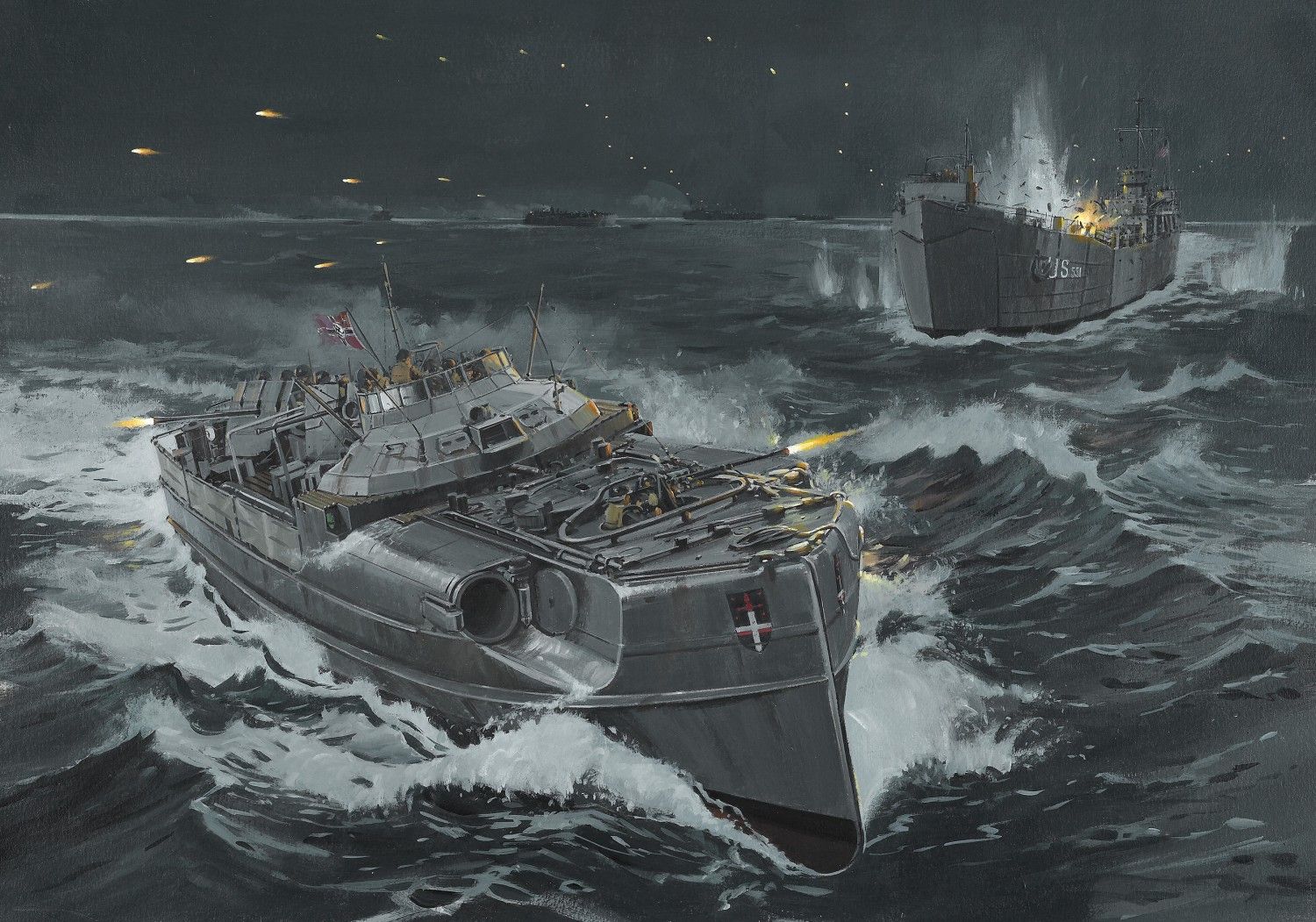
The Battle of Lyme Bay, 28 April 1944 src: Mark Beerdom via pinterest
The battle happened off Portland, Lyme Bay in the English Channel and an US Convoy went apparently off-course, comprising 8 LSTs protected by a Corvette. The battle resulted in the loss of two LSTs while two other were badly damaged, 749 killed and more than 200 wounded, for no loss on the German side, which deployed a whole squadron of nine Schnellboote. Convoy T-4 was carrying vehicles and precious staff and personal from the 1st Engineer Special Brigade. It was spotted in Lyme Bay by nine German E-boats which left Cherbourg shortly after midnight and evaded successfully the barrage of patrolling British MTBs. Around 0130 hrs the first six E-boats of 5th S-Boot Flottille (Korvettenkapitän Bernd Klug) spotted eight dark ships, and deployed into three pairs to torpedo attack, Rotte 3 (S-136 & S-138), Rotte 2 (S-140 & S-142), and Rotte 1 (S-100 & S-143).
Three more E-boats from S-Boot Flottille Götz Freiherr von Mirbach (S-130, S-145 & S-150), later spotted red flares and joined in at full speed. S-100 collided with S-143 and were damaged enough to leave under over of smoke while S-145 attacked the convoy at short range with gunfire. The attack ceased around 0330 hrs and the corvette HMS Azalea was at the end of the straight line and missed the battle. HMS Scimitar also missed the batle due to repairs, and it went missing in communication because of different standards. HMS Saladin was dispatched but never arrived in time. It could have change the outcome. The Corvette had a single gun and was mostly fitted with ASW grenades. LST-289 basically was set on fire but survived, LST-507 torpedoed and sunk, as LST-531 and LST-511damaged by friendly fire from LST-496.
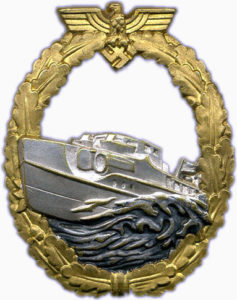 One month later on June 6, E-boats of the 9th flotilla left Cherbourg harbour at 5 a.m. on 6 June 1944, spotted the entire invasion fleet and closed in, moving in pair to divert attention and counter fire, laying smoke to cover their approach, and fired their torpedoes at maximum range. They quickly retreated and returned to Cherbourg, not achieving a single kill.
One month later on June 6, E-boats of the 9th flotilla left Cherbourg harbour at 5 a.m. on 6 June 1944, spotted the entire invasion fleet and closed in, moving in pair to divert attention and counter fire, laying smoke to cover their approach, and fired their torpedoes at maximum range. They quickly retreated and returned to Cherbourg, not achieving a single kill.
These numerous clashes were celebrated at home, less than U-Boat exploits, they never were that popular. Crew members could earn the “Schnellbootkriegsabzeichen” a badge depicting an E-boat passing through a wreath as a dedicated award. The criteria were good conduct and distinction in action, plus participating in twelve enemy actions. It could be also awarded under special circumstances or upon proofs of the utmost gallantry. In all until the end of the war, E-boat crewmen were awarded 23 Knight’s Cross and 112 Gold Cross.
Clashes in the Mediterranean
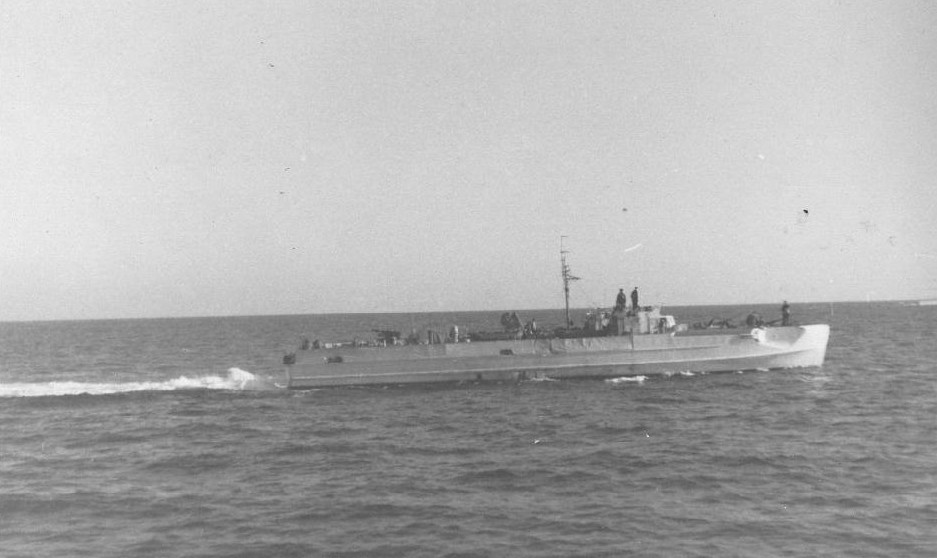
Some Schnellboote were transferred in small numbers to the Mediterranean, by land and river. There was always the possibility to sail along the French and Spanish coast down to Gibraltar, but crossing it afterwards would havve been a suicide and there was no way to cross spain via canals or river west to east. Two operational units were created, the 3rd flotilla (3.schnellbootflottille), which was created on 15.5.1940 first fot the coast of the Netherlands and Belgium. It was transferred to Vindava in Eastern Baltic in 1941 and by the fall of the year, to the Mediterranean Sea. In 1943 it was part of the 1st division of torpedo boats. Also the 7th flotilla created on 10/01/1941 in Swinemunde and trained until April 1942 were under command of the 5th flotilla, stationed in the Baltic. By November 1942 they went along European rivers down to the Mediterranean Sea.
Clashes in the Black sea
Some Schnellboote were based in the Black Sea. Ordered by the OKW, these were the six E-boats of the 1st S-flotilla, released from action in the Baltic and refitted. They operated from the Romanian port of Constanța. It was quite a logistical feat to transport them: Superstructure and all weapons were removed and carried by train, and the hulls arrived at Ingolstadt, and were transferred to water, reaching Linz. There, they were reunited with their superstructures and equipment and proceeded down the Danube to Galați, to receive their main engines and interio fittings. Complete, they headed by themselves for Constanța, and then supplied with ammunition and the last equipments, in 24-26 May 1942. S-27 was lost in operation after a malfunctioning torpedo, and later four more boats to be kept in reserve were setn the same way, S-47, S-49, S-51, and S-52. S-28, S-72 and S-102 were in heavy maintenance, leaving the S-26 and S-49 in operatio but by January 1944, the 1st S-flotilla had an operational strenght of six boats. S-28, S-40, S-45 and S-51 decommission for long maintenance work. Three more S-boats arrived and on 1 June 1944, the stranght was 8 boats (S-28, S-40, S-47, S-49, S-72, S-131, S-148 and S-149) but not sorties often due to fuel shortages. Four were later transferred to Sulina (Danube mouth). On 19 August, three were destroyed by a Soviet air attack. S-148 was lost to a mine off Sulina and later S-42, S-52 and S-131 in turn were destroyed by Soviet air attack. For all this time, they disrupted the traffic, attacking merchant convoys.
Operation Jungle: NATO’s Spec-ops S-Boats
At the end of the war about 34 E-boats were surrendered to the British and three of them, P5230 (ex S-130), P5208 (S-208), P5212 (S-212) were intensively tested. The Gehlen Organization was an intelligence agency created by the US occupation forces in Germany, manned by former Fremde Heere Ost (Foreign Armies East). They used these three Royal Navy’s E-boats to infiltrate the Baltic states and Poland. The idea came from RN Commander Anthony Courtney, the operation planned and carried out by John Harvey-Jones (Naval Intelligence Division). P5230 was modified to reduce its weight and has two extra cruiser, silent Napier Deltic engines (2,500 hp each). Operation Jungle also tried to preventing Soviet navy vessels from interfering with German fishing boats and destroy stray mines. They were based in Kiel and they landed Lithuanian agents in 1949 up to 1955 replaced by three new Bundesmarine motorboats.
The Royal Danish Navy bought twelve former S-Boote after the war, augmented in 1951 by six more formerly in the Royal Norwegian Navy. P568 Viben, the last active, was retired in 1965.
Operators
Yugoslavian Orjen class
Outside Germany, Yugoslavia was the first country to use the S-Boat. Indeed, the Orjen class were built in Germany by Lürssen, based on the S2 class in 1936. They had a 7kts cruiser speed thanks to a single 100hp Maybach engine which propelled a central shaft. Numbered at first 1-8, they became the Orjen, Dumitor, Suvobor, Kalmakclalan, Velebit, Dinaira, Rudnik, and Triglav. On 16 april 1941 Durmitor and Kajmakcalan successfully escaped to allied-occupied Crete, and later sailed to Alexandria. They went back in service with the new Yugoslavian Navy as TC5 and TC6, discarded 1962-1963. The others were captured and reused by the Regia Marina (MAS3D-8D and MS41-46 by 1942). Two scuttled September 1943, other captured, used by the Kriegsmarine and scuttled in 1944.
Italian MS boats:
The limited seaworthiness of MAS boats used at the start of World War II led the Regia Marina to order vessels similar to German E-boats, the CRDA 60 t type, “MS” (Motosilurante). The prototype was derived from one of the earlier E-boats from the Yugoslav Navy, captured in 1941. In all, 36 MS-Boats were built, in two batches of 18 (Type 1 and 2) by CRDA in Montfalcone. They both had two 21-in TTs, two 20 mm Breda guns and LMGs, but the Type 2 in addition had two 18-in TTs two more Breda 20 mm guns, and all possessed Depth charge racks. Later, the Italians devised a derivative called VAS boats specifically tailored for ASW warfare, circa 60 boats. MS-boats scored the biggest kill fo this kind of boats of the war, sinking the cruiser HMS Manchester in August 1942. They stayed in service during the early cold war as well, some until the 1970s.
Spanish Schellboats (motolancha)
S-Bootes also saw service with the Spanish Navy as Franco was awarded six E-boats during the Spanish Civil War, and six more during WW2 plus six more built in Spain with Lürssen assistance. They were not numbered but named. “Falange” allegedly laid two mines off Almería crippling the British destroyer HMS Hunter on 13 May 1937. They served until the 1960s-70s for some.
Romanian S-Boats:
Germany sold four E-boats to Romania on 14 August 1944, 65 tons boats capable of 30 knots thanks to their three Mercedes diesels totalling 2,850 hp. They were peculiar as having smaller, 500 mm (19.7 inch) torpedo tubes. These were the former S-151, S-152, S-153 and S-154, renamed and active in the black sea in the Romanian Navy until 1954.
Chinese S-Boats:
The Chinese Nationalist Navy operated three S-7 class boats during the Second Sino-Japanese War: Yue-22, 253 and 371. The first was destroyed by Japanese aviation, Yue-371 scuttled to avoid capture and Yue-253 captured by the PLAN in 1949 during the civil war. It was renamed HOIKING and was used as a patrol boat until 1963. The Chinese Nationalist government ordered also eight S-30 class boats and a tender (Qi Jiguang) to Germany but they were requisitioned in September 1939, the tender being renamed KMS Tanga.
extra photos: https://commons.wikimedia.org/wiki/Category:S-Boot
Nomenclature of S-Bootes
Lürssen S 1 (1930)
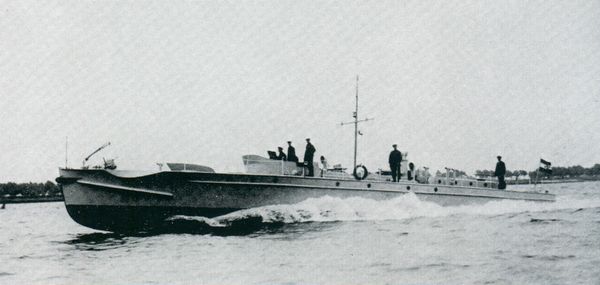
While the Reichsmarine was renamed in March 1935 the Kriegsmarine the S 1 entered service, later integrated into the 1st Schnellboothalbflotille. It was supported by the escort ship “Tsingtau”. Built in 1930 at Lürssen Vegesack, S1 derived from a long lineage started by Kaptain Lohman and his Seetransportabteilung. In 1923-26 already, former Imperial LM20-23, 27, 28 were modified and in 1926, Abeking & R. delivered the “K”, a 40 knots copy of the British Thornycroft 55ft CMB. Lürssen “Lür” followed at the same time, pitted against a third competitor, Narwhal from Caspar Werft Travemünde. These three boats were renamed UZ-11 to 18, officially sub-chasers. But Lürseen collaboration with K-Amt wich alreayd signed the yacht Oheka II. In 1930, UZ-16 (ex-Lür) became W1 and in 1932, S1. The boat mostly was used for trials and was operational in the 1st flotilla until 1938, when it was sold to Franco’s Spain.

Tech profile of S1. The S2 serie was about one meter longer.
Specifications
Displacement: 39t, 50t FL
Dimensions: 26.80 x 4.20 x 1.06m
Propulsion: 3 Daimler-Benz petrol, 2,700 hp. 34.2 knots.
Armament: 2x 500 mm TTs, 1x 20 mm gun.
Crew: 18
Lürssen S 2 group (1932)
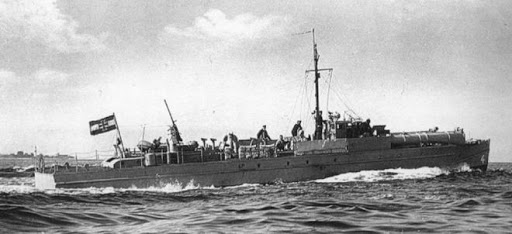
S4 bearing the Reichsmarine flag, after commission. Slightly longer hull but essentially similar to the S1, they had the same engine arrangement but with upgraded petrol engines for a better output but apparently a slight loss in speed (33.8 versus 34.2 knots). Armament was also the same. In 1938 these four boats were sent to Franco and were no longer in the inventory in 1939.
Specifications
Displacement: 46t, 58t FL
Dimensions: 27.95 x 4.20 x 1.06m
Propulsion: 3 Daimler-Benz petrol, 3,300 hp. 33.8 knots.
Armament: 2x 500 mm TTs, 1x 20 mm gun.
Crew: 18
Lürssen S 6 group (1933)

The first series of 4 units, S6 to 9, S10 to 13, S14 to 17, and the eight of the group of S18 were in service in 1939. They went from 32.40 to 34.62 meters and from 80 to 92 tons empty. They were capable of 35 to 37 knots. The S6 group adopted MAN diesels for the fist time, which benefited to range, but they proved unreliable. Output was better, but due to much increased dimensions and almot sdouble displacement, top speed was limited to 35 knots. Upgrade in armament as they now carried larger standard 53 cm torpedoes and were large anough to carry two spare torpedoes. Reloads operations were complicated at sea. The crew was slightly larger to 21, which stayed standard until the S701 of 1944.
With the “S 6”, the Reichsmarine received its first diesel boats. Their three MAN L-7 four-stroke diesels delivered 960/1320 hp each. With 36 t their first speed trial showed only a top speed of 32 knots. S7 and 9 were commissioned in 1934 and 1935. The risk of explosion was reduced and low fuel consumption also reduced operating costs. These were given a foredeck with kinked ribs in order to improve seaworthiness.
In September 1934, Captain Günther Schubert took command of the second semi-flotilla and all the S-1 to S-8 boats were combined in 1935 as the 1st Schnellbootshalbflotille conducted by the escort ship “Tsingtau” in service by September 24, 1934.

S6 Specifications
Displacement: 78t, 92t FL
Dimensions: 32.40 x 4.90 x 1.21m
Propulsion: 3 Daimler-Benz diesels, 6000 hp. and 39.5 knots max.
Armament: 2x 533 mm TTs (2 in reserve), 1x 20 mm gun.
Crew: 21
Lürssen S 10 group (1934)
No big changes in this serie, slightly lighter becayuse equipped with more compact and more reliable Daimler Benz engines, which procured the same output, also for 35 knots. The rest of the specs were identical.
Specifications
Same but displacement: 78t, 95t FL
Propulsion: 3 Daimler-Benz diesel, 3,390 hp. 35 knots.
Lürssen S 14 group (1936)
Since the top speed of the S 10 group did not meet the military requirements, Lürssen for the next S 14 commissioned in 1935 adopted larger MAN four-stroke diesel engines L 11. This required a larger hull and greater displacement, but the prize was a sustained 37 knots but burst of 39.8 knots. The rest was basically a repeat of previous boats.

Specifications
Displacement: 92t, 114t FL
Dimensions: 34.62 x 5.10 x 1.44 m
Propulsion: 3 MAN diesel, 6,150 hp, 37.5 knots.
Lürssen S 18 group (1938)
Basically a repeat of the S14 group with minor modifications, and faster. S18-25 entered service in 1939.

Specifications
Displacement: 92t, 115t FL
Propulsion: 3 Daimler-Benz diesel, 6,000 hp. and 39.5 knots max.
Lürssen S 26 group (1940)

The four of the S26 group dating back to 1940 prefigured the large wartime series. These were the first with torpedo tubes cast into the hull. There were also 16 additional type “export”, close in characteristics of the S10 group. (S30-37, 54-61). All were completed in 1940-41. They were capable of 36 knots. Their hull was a tad longer at 34.92 m and deeper at 1.52 m.
This increased the reserve buoyancy, protected exhausts from the weather, and the command post was moved back to the front of the bridge. On August 1st, 1938 2.SFltl was deployed in exercises, assisted by the escort ship “Tanga”. Two flotillas were subordinate to the TB leader (FdT).
Lürssen S 30 group (1939-41)

Basically export models, slightly smaller, lighter, but also less powerful and fast than the S 26 group. Same armament. When the war broke out, eight boats of this group were under construction for export customers and requistioned, renamed S 30 – S 37, deployed until the summer of 1940.
Specifications
Displacement: 81-82t, 100-102t FL
Dimensions: 32.76 x 4.90 x 1.21 m
Propulsion: 3 DB diesel, 3,960 hp, 36 knots.
Crew: 16
Lürssen/Schlichting S 38 group (1939-43)
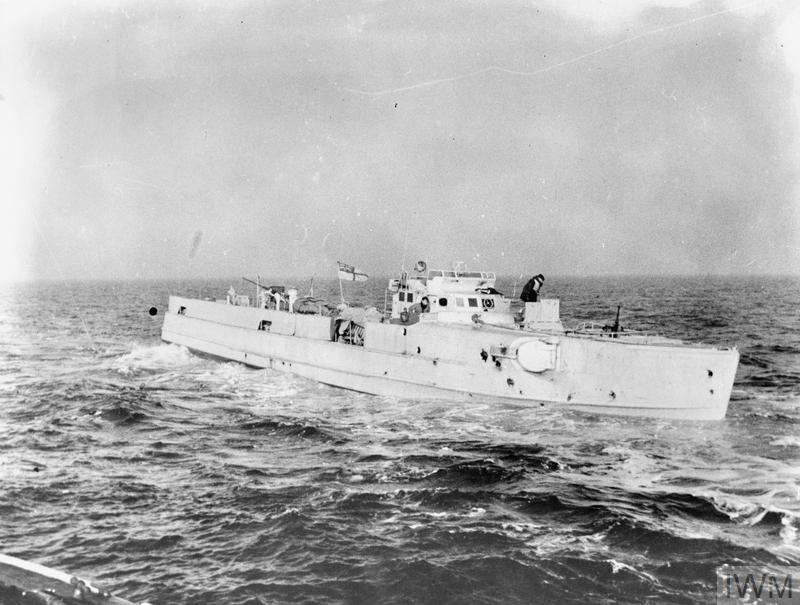
S38 group – IWW
S-bootes of the S38 group derived directly from S26. This became the “standard” wartime type, valid until the end of the war, with weapons additions in later developments. This S38 group consisted of 90 units, the latter entering service in 1943. Some were built in Schlichting, Travemünde, and from S 67 they received a new armored bridge, reshaped in a “tank turret” style adopted by the S 100. AA additions ranged from 3 x 20 mm and a 40 bofors/37 mm FLAK to two twin 20 mm, a Bofors and a 37 mm. They were also capable of carrying mines and depht charges. Between November 1940 and September 1941 S 38 to S 53 were kept in port for trials and training, with three MB 501 diesels. They also had a brand new 2 cm Flak embedded in the forecastle, served by a ring mount. Reinforced, it was later able to carry a twin mount.
Specifications S38
Dimensions: 34.94 x 5.10 x 1.52m
Variable armament, rest as S 26.
Lürssen S 100 group (1943-45)
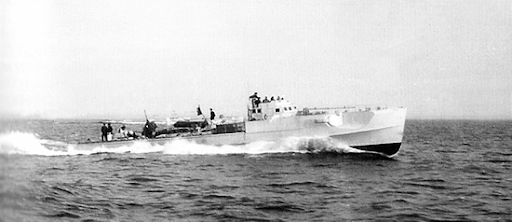
The S100 group of 1943 included 86 units, equipped with new more powerful Mercedes Benz diesels. It allowed them to be much faster. For the first of the series, these engines gave 7,500 hp for 42 knots and the rest of the order 9,000 hp for 45 knots. They were fitted with a 40 mm AA Bofors gun instead of a 20 mm gun. The series stopped at S 500 but in reality after 347 units ordered. 261 were never completed or even never started, leaving 85 in active service.

Specifications as S38 but:
Displacement: 100/105/107 tons standard, 117 to 124 DP.
Propulsion: 3 Daimler-Benz diesel, 7,500/9,000 hp, 42-45 knots.
Armament: 2x 533 mm TTs, 1x 40 mm, 1x 20 mm guns, see notes.
Lürssen S 701 group (1944-45)

S-Bootes of the 701 group of 1944 had four tubes loaded and ready to fire, bow tubes and additional two set obliquely on the aft deck. The group S701 of 1944 was destined to a larger and faster mass production to counter the long awaited allied landing operation. The Yard was repeatedly bombed by the RAF and under Albert Speer, construction was delegated to multiple units, built in tunnels, underground, old quarries and transported by train, by the Danziger Waggonfabrik. Of the planned 100 units (S701-S800), only 8 were ever completed, early in 1945. They were the first to have four torpedo tubes, and twin 30 mm FLAKs which proved troublesome and were replaced in completion by standard twin 20 and 40 mm guns.
Danziger Waggonfabrik commissioned the first boats based on the plans of the model 219. Their two stern torpedo tubes were firing astern, covered and hidden by canvas. No reloads therefore were necessary at sea. The planned armament of three twin 30 mm automatic cannons was quite ambitious but never ready in time, but would have procured the best firepower of any light boat of that time.
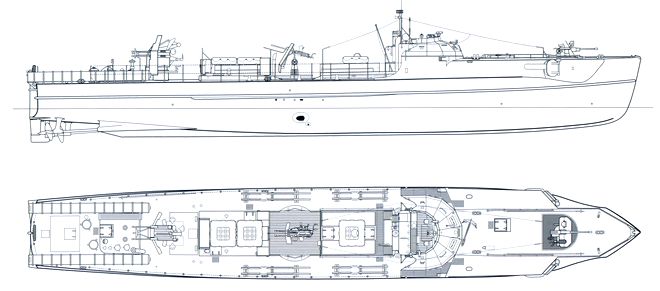
S701 group schematics – From Steve Wiper: German S-Boats
Specifications
Displacement: 107t, 114t FL
Dimensions: 34.94 x 5.10 x 1.52m
Propulsion: 3 Daimler-Benz diesel, 7,500 hp, 42 knots.
Armament: 2x 533 mm TTs, 1x 40 mm, 1x 20 mm guns, see notes.
Crew: 23
Midget S-Bootes: LS1 class (1942-45)
The Leichte Schnellboote (LS)
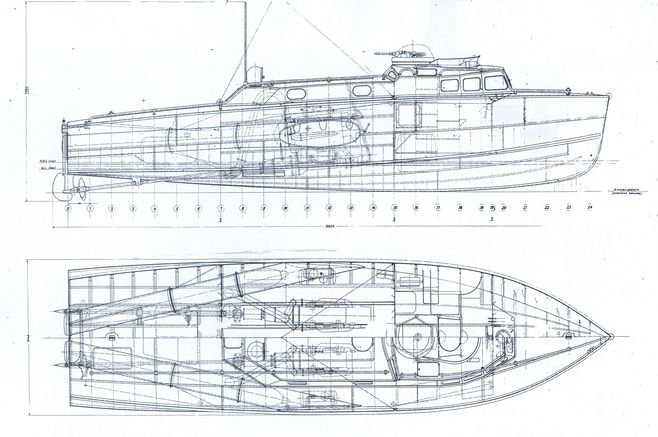
When the war broke out, mini-speedboats LS 1 and LS 2 had been designed to be carried and deployed by auxiliary merchant cruisers and German well-armed merchant raiders. Indeed some were carried in the first missions, but proved disappointing in operations. These light metal boat were developed by Dornier, an aicraft manufacturer, completed and brought first carried by the auxiliary cruiser “Komet” (HSK 7) and “Meteor”. The planned 45 cm torpedoes (airbone model) was not ready in time, so these boats carried three mines and could be used as a fast minelayers for port entrances. The built-in aircraft engines also caused problems. In the spring of 1940, four more boats were commissioned from Dornier. They had the new Daimler-Benz light diesel engines MB 507, which equipped LS 3 and LS 4. They also received a new mine release device, allowing to carry four mines. LS 3 was delivered on October 14, 1940, used onboard “Kormoran” (HSK 8). LS 4 at last received its intended two stern torpedo tubes and the newly developed propeller allowing to reach 42.5 knots. It served on the “Michel” (HSK 9). For the next batch, LS 5 and 6, only Junkers aircraft engines were available. Both were prepared under OKW instructions as ASW vessels, with depht charges, and deployed in the Aegean Sea. Howevr their associated vehicle MR 7 was relocated to the Black Sea and both LS boats were left unusued. The LS 7-LS 12 serie were given the MB 507 engine and carried torpedoes. LS 7 was delivered on October 8th, 1943 and the last, LS 12, on July 12th, 1944. LS 7-LS 11 were deployed in the Aegean Sea but LS 12 ended in Yugoslavia, used by the torpedo research institute, and became a Russian war prize.
Riverine S-Bootes: KS class “Hydra” (1945)
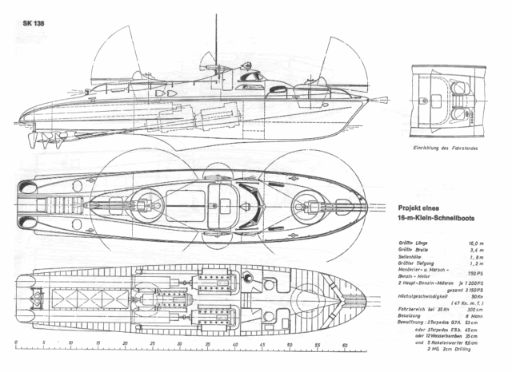
At the end of 1944, the Construction Office of the High Command of the Navy (OKM) made comparative tests of prototypes “Hydra”, “Kobra”, “Schlitten” and “Wal” anwsering to a navy spec for light coastal TBs. “Hydra” won the contest but still failed to meet requirements. It was longer than the required 10 m maximum to be carried on a standard truck trailer. It was powered by two Avia-Hispano-Suza Otto aircraft engines with an output of 650 HP each, without reversing gear. These boats also carrier two aviation torpedoes of the F5b type, 45.7 cm, launched by the stern, and a single an anti-aircraft machine gun for self defense. The design was shortened and eventually approved on December 4th, with a series of 50 boats ordered from various shipyards: Lürssen, Kröger, Danziger Waggonfabrik, Schlichting, and Vertens. A second order for 115 boats was made on 02/08/1945. But in May 1945 only 39 had been completed, organized under the Hydra special command (‘1st Hydroflotilla’). No Operational deployment registered. This unit comprised the KS-201, 202, 212, 213, 215, 219 and 220.
Küstenminenleger:
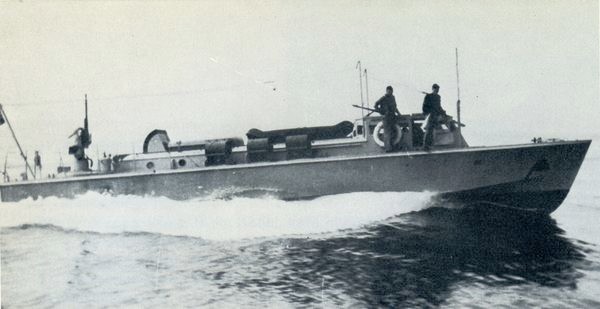
Picture, Fock “Schnellboote Bd. 2”
This class of small fast attack boats were designed as light coastal minelayers able to carry up to 4 mines, and operate close to enemy coastlines. Very small, less than 16 meters they were lightly armed and counted on their small size and speed to evade. 36 boats were ordered, plagued by unreliable engines, so theyr were used for riverine operations on the eastern front instead. 20 were equipped with torpedo tubes and some re-equipped as mine hunters. Most were captured or gave as war prize to the Soviets. In 1943/44 some KM boats used for coastal minelaying were converted as small speed boats. They were were built at six different shipyards and redesignated “KS” boats, assigned to the 22nd Schnellbootflotille deployed in the Adriatic, and then handed over to the small Croatian Navy in the autumn of 1944 and then taken back by the Kriegsmarine after the latter returned their jacket and started a partisan war.
Projects:
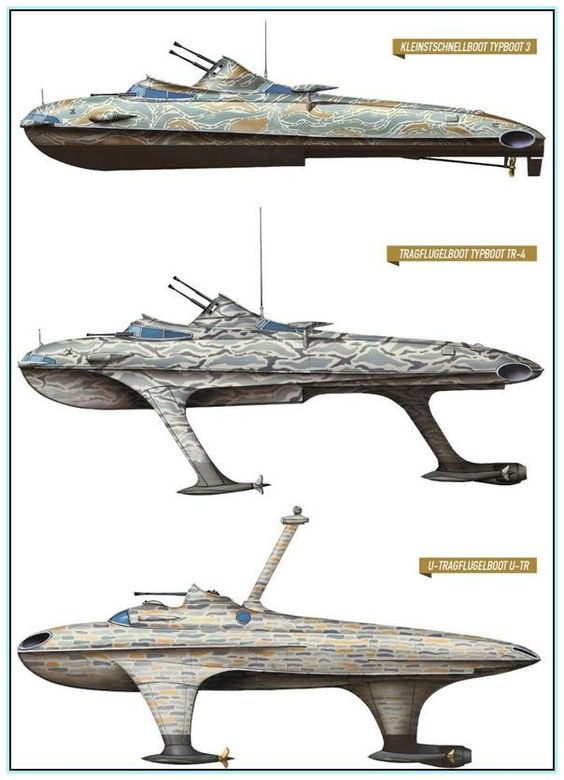
Type 3, Type 4 and UTR-type fast attack crafts, unbuilt K-Verband projects (from pinterest)
Kleinstschnellboot Projekt:
A Project of a small fast attack boat, called “Typboot 3”. It was the result of the evolution of small attack craft designs by K-Verband in 1944/1945. These were intended for coastal areas after the invasion in Normandy, counting on its speed and small size. It was the base for further developments notably in the area of Hydrofoils. None was built.
Known specifications: Dimensions 14,2 m x 3,0 m x 1,2 m, armed with no less than five 2 cm autocannon and a single 1,3 cm AA Machine Gun, four 86 mm Rocket Launcher and two 45,7 cm Torpedo tubes, or in alternative ten Depth Charges. Propelled by a 3-shaft arrangement for aviation high octane petrol engines for 2100 hp total, 47 to 50 knots (est. trials)
Tragflügelboot Projekt:
A Project of a small hydrofoil attack boat, it was based on the previous design, but fitted with foils. Called Typboot 4, this design was the result of earlier studies to reach faster target approaches and disengagement. In addition to the foils there was a 400 hp power increase, for an additional 8 knots, so around 55-56 knots top speed. However at that stage, Germany had no operational experience for hydrofoils whatsoever. Specs were about the same as the Type 3, but it towered at 3 meters above the waves when up. Armament was reduced to four 20 cm autocannons in the nose, and five rocket launchers. None built.
Turbojet Tragflügelboot Projekt:
Another hydrofoil using a small turbojet, this was an incremental step to reach better speeds, and facilitates disengagement and approaches. The shaped hull have made wonder some authors of its possible stealthy qualities, in addition to a wood construction. Called Project 5B, this hydrofoil possessed the same tripod foil arrangement (two forward, one aft), and general specs were unchanged but the weight with the additon of two Jumo turbojets. Tests were already performed by K-Verband in 1944, with the “Tornado”, which underline several issues, notably its use by calm sea only and control problems. But the boost it procured was seen as a real advantage as with the addition of the two TBJ adding a total of 2900 kp top speed reached now 65 knots.
Submersible Tragflügelboot Projekt:
This was a small submersible hydrofoil attack boat, not unlike the Manta, which was even more radical. Another way to approach allied fleets, was to have a submerged MTB. It was a submersible hydrofoil, so capable of 55+ knots top speed when surfaced to attack, but also equipped with a Schnorchel and periscope. It could be used for stealthy approach and in shallow waters. It had dive tanks and rear torpedo tubes. Technical data is unavailable, but estimated comparable to other Wendel FACs.
Read More:
www.s-boot.net/englisch/sboats-kriegsmarine-types.html
www.german-navy.de/kriegsmarine/ships/fastattack/index.html
weaponsandwarfare.com/2015/11/11/german-schnellboot-s-boat/
weaponsandwarfare.com/2019/06/29/mediterranean-coastal-and-torpedo-craft/
weaponsandwarfare.com/2017/09/19/type-s-100-s-700/
www.modelwarships.com/reviews/books-plans/warship-pictorial/wp-15/wp-15.html
www.rovcom.co.uk/s130_ww2_schnellboot.htm
www.pt-boat.com/sboot/sboot.html
www.bmpt.org.uk/boats/S130/index6.htm
underwatermalta.org/discover/schnellboot/
//schnellbootnet.jimdofree.com/kriegsmarine-s-boot-typen/
en.wikipedia.org/wiki/E-boat
www.werkgroep-kriegsmarine.nl/km_nl_sboote_GB.htm
www.foerderverein-museums-schnellboot.de/s-boote/kriegsmarine/km-wappen.htm
schnellbootnet.jimdofree.com/kriegsmarine-s-boot-waffe/
On alternate history
Books:
Schnellboote: A Complete Operational History by Lawrence Paterson
Bellars, Robert A. & Freivogel, Zvonimir (2010). “Question 24/46: German E-Boats Based in Sicily”. Warship International.
Dallies-Labourdette, Jean Philippe (June 2003). German S-boote at War, 1939–1945. Histoire and Collections.
Krakow, David (August 2013). Schnellboot in Action (2nd (Warships) ed.). Squadron/Signal Publications.
Krakow, David & Connelly, Garth (January 2003). Schnellboot in Action (Warships). Squadron/Signal Publications.
Williamson, Gordon; Palmer, Ian (September 18, 2002). German E-boats 1939–45. Osprey.
Macpherson, Ken. Ships Of Canada’s Naval Forces (Warships). Collins Publications.
Williamson, Gordon (2011). E-boat vs MTB: The English Channel 1941–45. Oxford ; Long Island City: Osprey.
Margaritis, Peter (2019). Countdown to D-Day: The German Perspective. Oxford, UK & PA, USA: Casemate.
The models’s corner:
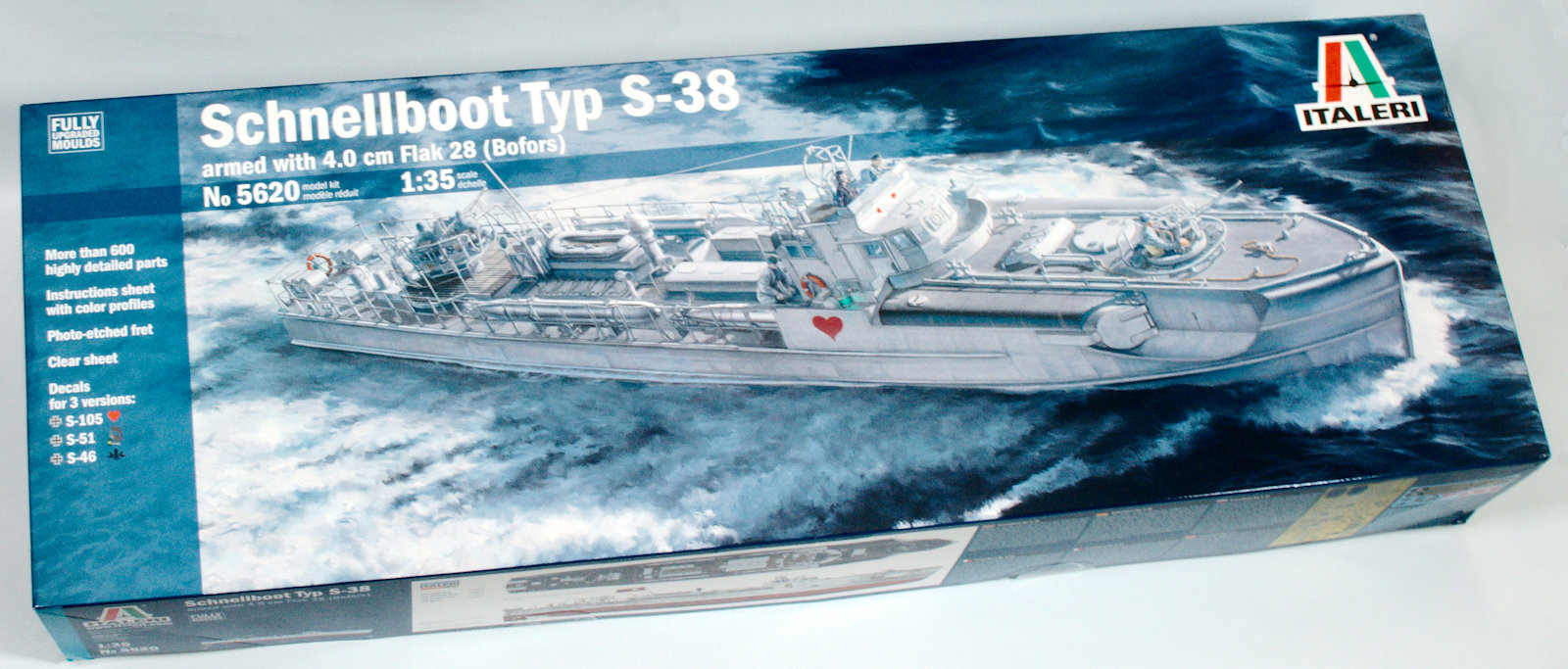
Italeri made the S-38 and S-100 at 1/35 scale
https://www.themodellingnews.com/2018/03/in-boxed-italeris-schnellboot-s-38-in.html
Videos:
https://www.youtube.com/watch?v=i8A9Rr9JQNA
Stukas Of The Sea – German Speedboats In World War II
Mark Felton, the last E-Boat
German Patrol Boats of World War 2 (Deutsche PatrouillenSchiffe des zweiten WeltKriegs)

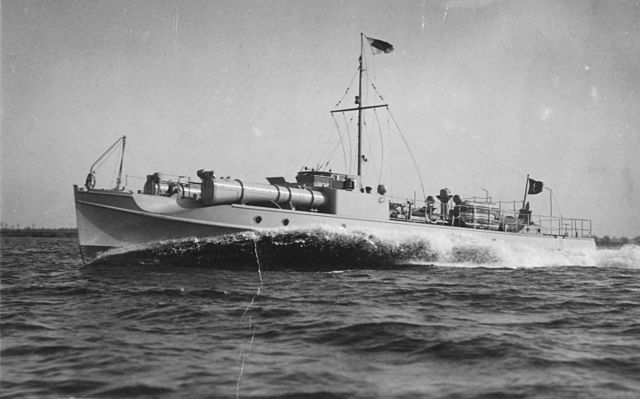
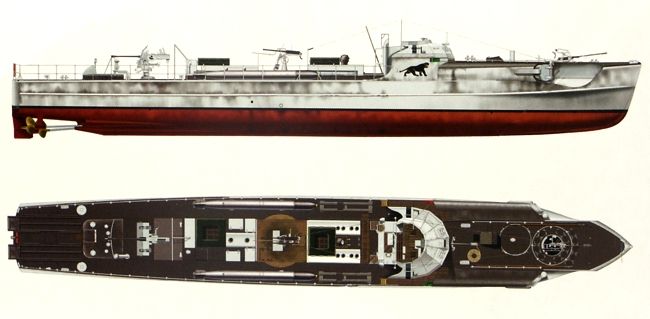
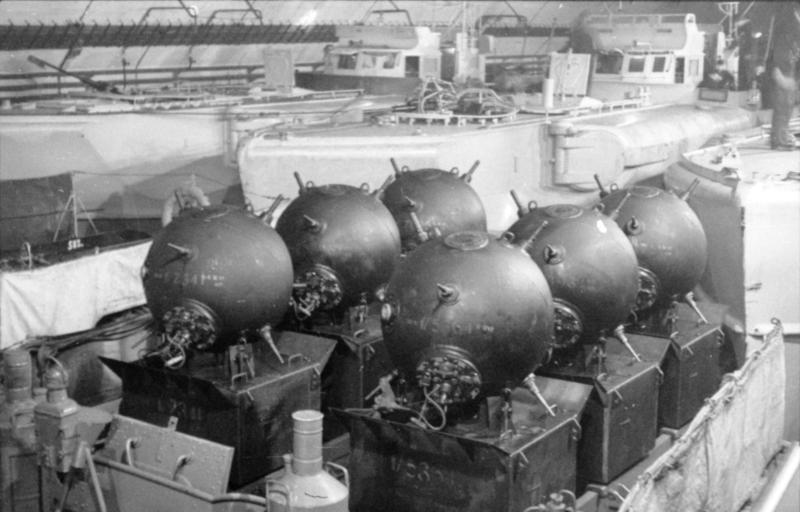
 Latest Facebook Entry -
Latest Facebook Entry -  X(Tweeter) Naval Encyclopedia's deck archive
X(Tweeter) Naval Encyclopedia's deck archive Instagram (@navalencyc)
Instagram (@navalencyc)





 French Navy
French Navy Royal Navy
Royal Navy Russian Navy
Russian Navy Armada Espanola
Armada Espanola Austrian Navy
Austrian Navy K.u.K. Kriegsmarine
K.u.K. Kriegsmarine Dansk Marine
Dansk Marine Nautiko Hellenon
Nautiko Hellenon Koninklije Marine 1870
Koninklije Marine 1870 Marinha do Brasil
Marinha do Brasil Osmanlı Donanması
Osmanlı Donanması Marina Do Peru
Marina Do Peru Marinha do Portugal
Marinha do Portugal Regia Marina 1870
Regia Marina 1870 Nihhon Kaigun 1870
Nihhon Kaigun 1870 Preußische Marine 1870
Preußische Marine 1870 Russkiy Flot 1870
Russkiy Flot 1870 Svenska marinen
Svenska marinen Søværnet
Søværnet Union Navy
Union Navy Confederate Navy
Confederate Navy Armada de Argentina
Armada de Argentina Imperial Chinese Navy
Imperial Chinese Navy Marinha do Portugal
Marinha do Portugal Mexico
Mexico Kaiserliche Marine
Kaiserliche Marine 1898 US Navy
1898 US Navy Sovietskiy Flot
Sovietskiy Flot Royal Canadian Navy
Royal Canadian Navy Royal Australian Navy
Royal Australian Navy RNZN Fleet
RNZN Fleet Chinese Navy 1937
Chinese Navy 1937 Kriegsmarine
Kriegsmarine Chilean Navy
Chilean Navy Danish Navy
Danish Navy Finnish Navy
Finnish Navy Hellenic Navy
Hellenic Navy Polish Navy
Polish Navy Romanian Navy
Romanian Navy Turkish Navy
Turkish Navy Royal Yugoslav Navy
Royal Yugoslav Navy Royal Thai Navy
Royal Thai Navy Minor Navies
Minor Navies Albania
Albania Austria
Austria Belgium
Belgium Columbia
Columbia Costa Rica
Costa Rica Cuba
Cuba Czechoslovakia
Czechoslovakia Dominican Republic
Dominican Republic Haiti
Haiti Hungary
Hungary Honduras
Honduras Estonia
Estonia Iceland
Iceland Eire
Eire Equador
Equador Iran
Iran Iraq
Iraq Latvia
Latvia Liberia
Liberia Lithuania
Lithuania Mandchukuo
Mandchukuo Morocco
Morocco Nicaragua
Nicaragua Persia
Persia San Salvador
San Salvador Sarawak
Sarawak Uruguay
Uruguay Venezuela
Venezuela Zanzibar
Zanzibar Warsaw Pact Navies
Warsaw Pact Navies Bulgaria
Bulgaria Hungary
Hungary

 Bundesmarine
Bundesmarine Dutch Navy
Dutch Navy Hellenic Navy
Hellenic Navy Marina Militare
Marina Militare Yugoslav Navy
Yugoslav Navy Chinese Navy
Chinese Navy Indian Navy
Indian Navy Indonesian Navy
Indonesian Navy JMSDF
JMSDF North Korean Navy
North Korean Navy Pakistani Navy
Pakistani Navy Philippines Navy
Philippines Navy ROKN
ROKN Rep. of Singapore Navy
Rep. of Singapore Navy Taiwanese Navy
Taiwanese Navy IDF Navy
IDF Navy Saudi Navy
Saudi Navy Royal New Zealand Navy
Royal New Zealand Navy Egyptian Navy
Egyptian Navy South African Navy
South African Navy






























 Ukrainian Navy
Ukrainian Navy dbodesign
dbodesign
My late father in law served onboard an E boat in the Spanish Navy about 1956. They patrolled Gibraltar Straits chasing tobacco smugglers. He served the 37 mm gun, shooting across the smugglers boats’ bows to stop them. As he told me many years after, the boats invariably stopped!
Thanks for the life experience Jorge !
-Dave
Hello,
I’ve been reading a lot about S-Boats but can find very little or anything on how the crews (varying from 17-30) were deployed on board.
Does anyone know or have a link on how the crews were broken out as to duties?
Cheers,
Jim
Hi Jim,
Did you checked existing books in the matter ? On my part i have nothing much to add to this particular detail. German “field book manuals” are pretty rare, especially for the Kriegsmarine.